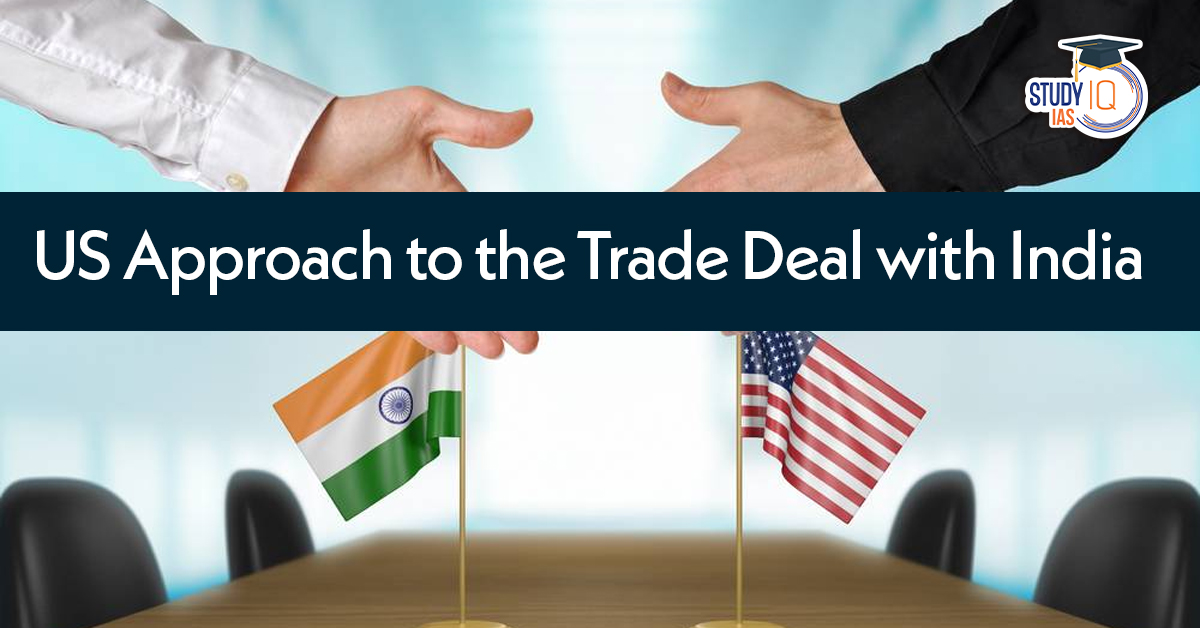Table of Contents
Context: As the U.S. tariff deadline nears, India is pushing to seal a trade deal. However, U.S. demands on agriculture have sparked concerns in India, especially about farmer livelihoods and market access.
US Approach to the Trade Deal with India
- One-Sided Concessions: India may offer tariff elimination on US industrial goods and a limited opening of agricultural markets.
- US reciprocation is weak — likely limited to a non-binding letter promising tariff treatment, not firm commitments.
- Forced Purchases: The deal may include mandatory multi-billion-dollar purchases of US goods: LNG, oil, aircraft, defence equipment, and farm commodities.
- Mirrors US deals with other countries (e.g., UK, Vietnam), where purchasing commitments were made under pressure.
- Regulatory Demands: Ease of doing business for US firms:
- Access to India’s government procurement market.
- Dilution of patent protection.
- Relaxed e-commerce norms for giants like Amazon and Walmart.
- Unrestricted data transfer by tech companies.
- Tariff Threats Despite Deal: Trump has threatened:
- 10% tariffs on all BRICS countries.
- 500% tariff on nations buying oil from Russia (India’s top supplier).
- Tariffs based on unrelated issues (e.g., Brazil’s tariffs after action on X).
- A deal doesn’t guarantee tariff protection.
| Country/Region | US Demands | Partner Country Concerns | Status | Likely Outcome |
| EU | Guaranteed purchases of US LNG, beef, aircraft; lower tariffs on US autos and steel; broad access to EU agriculture markets | Harm to EU farmers and auto sector; won’t drop CBAM; fears Trump may still impose tariffs | Talks are ongoing, but tense. Trump has threatened 30% tariffs | Uncertain |
| Japan | Guaranteed buys of meat, LNG, aircraft; access to rice and government contracts; relaxed auto standards | Rice is politically sensitive; risk of domestic backlash; fears deal won’t stop future US tariffs | Talks slow due to political resistance | No comprehensive deal expected; symbolic ties likely |
| South Korea | More duty-free access for US meat and LNG; relax food safety and auto rules; support US aviation | Fears of damage to farmers; concerns Trump will demand more post-deal; lack of trust despite existing FTA | Talks continue, but little headway | Possible MoU or narrow deal |
| Australia | Cut tariffs on US drugs, metals, meat; allow more access to agri and rare earths; commit to large US purchases (meat, energy, defence) | Resentment over US tariff hikes; trade deficit; reluctant to lock in quotas | Negotiations active, but unresolved | Mini-deal likely |
| China | Lower tariffs on US goods; commit to buying US energy and aircraft; reforms to SOEs, digital, and subsidies | Strong opposition to political demands; fears of losing strategic autonomy; deep distrust of US | Fragile ceasefire in select sectors | No broad deal, only standstills |
| India | Reduce tariffs on autos, dairy, grains; allow GM feed; remove data localisation; commit to big US buys (oil, gas, defence) | Impact on 700 million farmers; food security; digital sovereignty; fears of new tariffs even after deal | Final-stage talks for limited deal | Uncertain. Partial deal likely, US may still charge 15% base tariffs |
Potential Impact on Indian Agriculture
- Exposure to Subsidised Imports: The US demands zero-duty entry for:
- Dairy products (cheese, whey, milk powder) threaten over 80 million small dairy farmers.
- Frozen chicken legs impact 30 million informal poultry workers.
- Wheat and rice – risks of domestic price collapse, long-term import reliance.
- Push for GM Feed and Products: The US is pushing for:
- GM animal feed like soyameal and DDGS (Distillers’ Dried Grains with Solubles).
- GM oils like soybean oil
- India currently bans GM feed to protect its GM-free status and export markets (EU).
- US self-certification system makes it hard to verify GM-free imports.
- Regional Crop Impact: Duty cuts on US apples could hurt apple farmers in Kashmir and Himachal Pradesh.
- Tariff cuts on GM soy oil could damage India’s edible oil sector, affecting 6 million oilseed farmers.
- Vulnerability to Global Market Fluctuations:
- Historical examples:
- 2014–16 global price crash: could have devastated Indian farmers without tariffs.
- 2005–08 price spike: countries like Ghana, Nigeria suffered due to import reliance.
- Historical examples:
Conclusion
India is being pressured into a “MASALA” deal — Mutually Agreed Settlement Achieved through Leveraged Arm-twisting — with minimal benefits and major risks to its farming sector. With over 700 million Indians dependent on agriculture, India must avoid hasty concessions that threaten livelihoods, food security, and rural stability. Agriculture is not just a trade issue — it’s the backbone of the nation.


 Iran Nuclear Crisis and India’s Role f...
Iran Nuclear Crisis and India’s Role f...
 H1B Visa Program, Beneficiaries, Eligibi...
H1B Visa Program, Beneficiaries, Eligibi...
 Comparison Between India & France's ...
Comparison Between India & France's ...

























